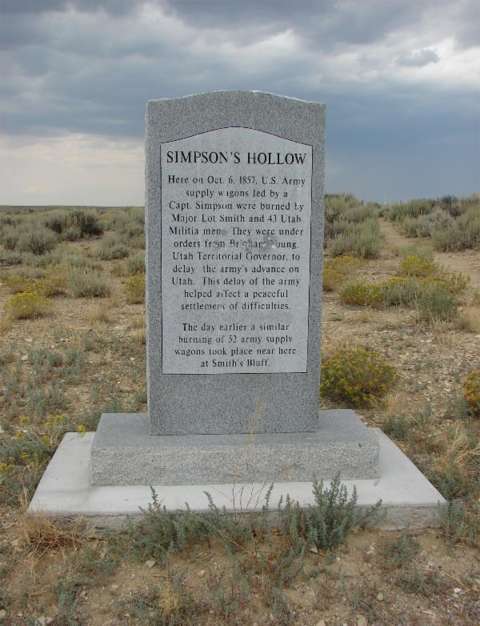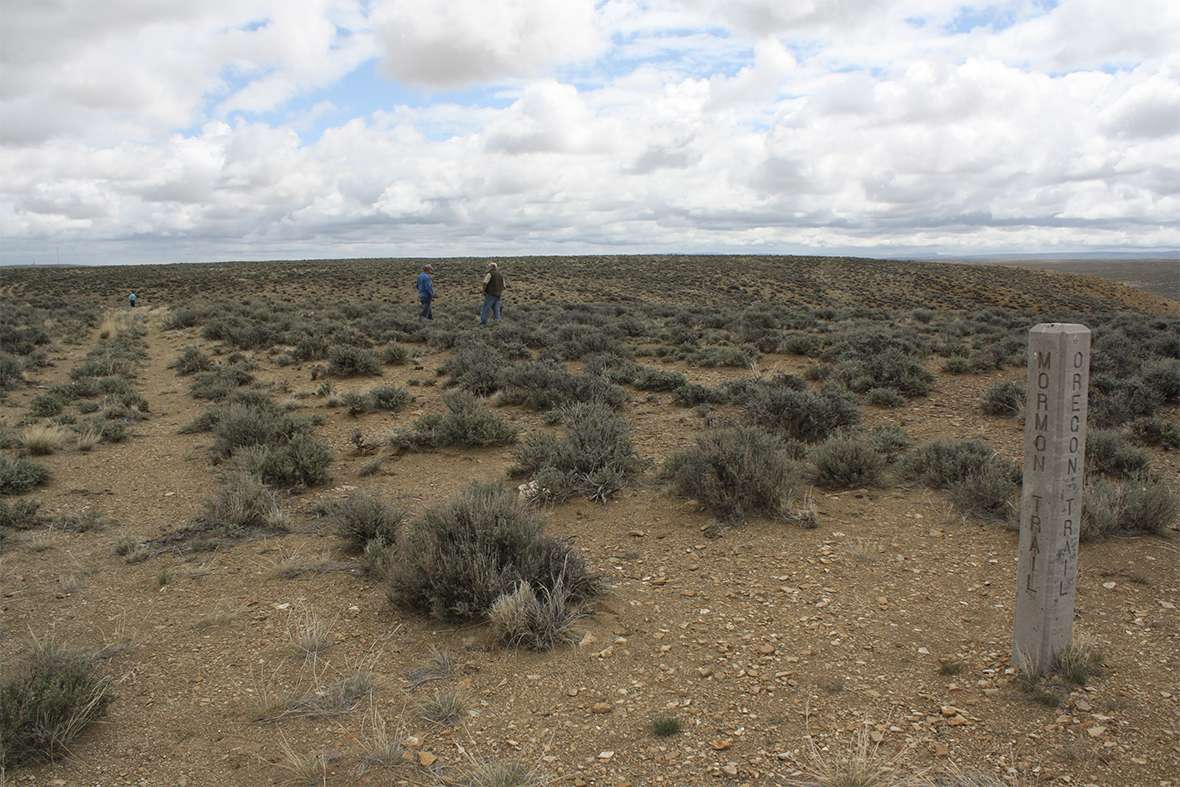- Home
- Encyclopedia
- Simpson’s Hollow, Flash Point In The Utah War
Simpson’s Hollow, flash point in the Utah War
On Oct. 5, 1857, a band of Mormon militia attacked U.S. Army supply wagons in three different places in what’s now southwest Wyoming, burning 76 wagons altogether and running off a great deal of livestock. No one was killed in these skirmishes.

Best known of the attacks was at a low spot in the sagebrush along the trail later named Simpson's Hollow, about 10 miles southwest of present Farson, Wyo., on Wyoming highway 28. The place is named after Lew Simpson, the wagon master. There, the militiamen captured and burned 26 wagons, and stampeded hundreds of army mules.
The supply wagons were part of an army of U.S. troops, 2,500 strong but marching in many small groups, advancing on Utah in the summer and fall of 1857 to enforce federal law in Utah Territory. Mormons had first arrived in the Salt Lake Valley in 1847. Utah had been a territory since 1850, with Brigham Young, president of the Church of Jesus Christ of Latter-day Saints—the Mormons—serving also as territorial governor and chief federal officer of Indian affairs.
Growing friction between the Mormons and federal judges and other territorial officials through the 1850s, however, together with widespread anti-Mormon feeling in the East, led newly elected U.S. President James Buchanan to appoint Alfred Cumming as the new governor for Utah. Buchanan ordered the army, under the command of Col. Albert Sidney Johnston, to ensure that Cumming and other federal officials could take up their new offices.
Buchanan and others expected trouble in dislodging Young. Although his term had ended in 1854, he had legally kept his post because the only replacement named before Cummings had refused to serve.
The militia, under the command of Capt. Lot Smith, was under orders from church authorities to harass and resist the army, bloodlessly if possible. They burnt supply trains, stampeded stock and burned as much grass as possible, to deprive the animals of feed.
Reports of the skirmish began reaching the East the following month.
On Nov. 14, William Carter, traveling on the Oregon Trail, wrote, “[We] came suddenly upon the smoldering ruins of 26 wagons which were corralled on each side of the road when burned by the Mormons.”
Four days later, on Nov. 18, the New Orleans Times Picayune reported, “The trains were altogether without any escort, and the teamsters made no defense of resistance whatever. … The contents were, I believe, mostly commissary stores. The supply sent out was estimated for a force of twenty-five hundred men for eight months.”
“The Utah expedition was supplied with full provisions for one year,” reported The Tennessean of Nashville, Tenn., on Nov. 21.
“I am authorized to say,” the account continues, “that the expedition will suffer not the slightest inconvenience from the loss of the destroyed trains, and that the force under Col. Johnston – two thousand men all told – are in no peril whatever from either the Mormons or the season.”
This would prove highly inaccurate, as winter was coming on, Johnston’s plans upset and provisions were drastically reduced. The army spent a very hungry winter near Fort Bridger—which also had been burnt by the Mormons—in what’s now southwestern Wyoming. Negotiations the following spring allowed the conflict to be settled peaceably.
In 1859, travelers on the Oregon Trail could still see traces of the burned wagons, and knew of the episode, although not necessarily the precise date of its occurrence. On June 23, 1859, more than a year and eight months later, emigrant J. A. Wilkinson wrote, “We saw today where the Mormons had burned a government train a year ago, giving the teamsters what provisions they could pack on their backs and drove the oxen to Salt Lake.”
“We passed more dead cattle today than any day yet, all of an ancient date however, we saw where several wagons had been destroyed by the Mormons,” John McTurk Gibson wrote on July 19, 1859.
British travel writer and adventurer Richard Burton rode in a stagecoach along the Oregon Trail in 1860. On Aug. 21 of that year, he wrote, “[W]e passed through a depression called Simpson’s Hollow, and somewhat celebrated in local story. Two semicircles of black still charred the ground; on a cursory view they might have been mistaken for burnt-out lignite. Here, in 1857, the Mormons fell upon a corralled train of twenty-three wagons, laden with provisions and other necessaries for Federal troops.”
Thus, Simpson's Hollow became notorious. The destruction of wagons in the vicinity, the burnt grass and evidence of other guerrilla tactics used by the Mormon church against the U.S. government marked an episode in what historians David L. Bigler and Will Bagley have called “America’s first civil war.”
On the north side of State Highway 28, there is a historical marker about Simpson's Hollow, and on the south side, Pilot Butte Interpretive Site, with more recent information.

Resources
Primary Sources
- Burton, Richard F. The City of the Saints and across the Rocky Mountains to California [1860]. London, UK: Longman, Green, Longman, and Roberts, 1861. American edition, New York: Harper & Brothers, Publishers, 1862. Reprinted as The Look of the West, Overland to California, University of Nebraska Press, 1963.
- Carter, William A. “Diary of Judge William A. Carter Describes Life on the Trail in 1857.” Annals of Wyoming 11:2 (April 1939), 75–113.
- Gibson, John McTurk. Journal of Western Travel. Manuscript at Saunders County Historical Society Museum, Wahoo, Nebraska. Typescript.
- “Interesting Letter from South Pass, Route of the Army to Utah.” New Orleans Times Picayune, Nov. 18, 1857, p. 4, col. 1.
- “The Mormon Attack on the Government Trains-The Condition of the Utah Expedition.” The Tennessean, Nashville, Tenn., Nov. 21, 1857, p. 2, col. 4.
- “The Mormon War Begun.” Ottawa Free Trader, Ottawa, Ill., November 21, 1857, p. 2, col. 2.
- “The News from the Plains.” Ohio State Journal, Columbus, Ohio, November 25, 1857, p. 4, col. 3.
- Wilkinson, J. A. Journal: Across the Plains in 1859. Edward E. Ayer Manuscript Collection, Newberry Library, Chicago, Ill. Richard Rieck transcript.
Secondary Sources
- Bigler, David L., and Will Bagley. The Mormon Rebellion: America’s First Civil War, 1857-1858. Norman, Okla.: University of Oklahoma Press, 2011, 203-231.
- Brown, Randy. Oregon-California Trails Association. WyoHistory.org offers special thanks to this historian for providing the diary entries and newspaper excerpts used in this article.
- Ramos, Donna G. “Utah War: U.S. Government Versus Mormon Settlers.” History.net. Accessed July 6, 2017, at http://www.history.net.com/utah-war-us-government-versus-mormon-settlers.htm.
- Wyoming Historical Markers. “Simpson’s Hollow.” Accessed July 6, 2017, at http://www.waymarking.com/waymarks/WMFBQK_Simpsons_Hollow.
- Wyoming Places. “Simpson's Gulch.” Accessed July 6, 2017, at http://wyld.sdp.sirsi.net/client/en_US/places/search/detailnonmodal/ent:$002f$002fSD_ASSET$002f0$002f1012917/ada?qu=Simpson%27s+Hollow&qf=SOURCE%09Source%09Places%09Places&te=ASSET.
- Wyoming State Historic Preservation Office. “Simpson’s Hollow.” Emigrant Trails throughout Wyoming. Accessed July 6, 2017, at http://wyoshpo.state.wy.us/trailsdemo/simpson's_hollow.htm.
Illustrations
- The photos of the Simpson’s Hollow markers are from Waymarking.com. Used with thanks.
- The photo of the Oregon/Mormon trail in the sagebrush near Simpson’s Hollow is by Tom Rea.
